The virus that causes COVID-19 was not the first pathogen to pass from animals to humans, and it surely won’t be the last. And though we may never pinpoint the exact animal source of SARS-CoV-2, we can hone our (re)search strategies to prepare for the next one.
To do just that, a new study has quantified the risk of naturally-circulating viruses jumping from their animal hosts, specifically mammals, into humans – with a focus on the global wildlife trade, both legal and illegal.
One-quarter of mammals swept up in the wildlife trade host 75 percent of all known zoonotic viruses, but domesticated and non-traded wild mammals were also not far behind, the research found.
“Annually, it is estimated that international wildlife trade results in upwards of one billion direct and indirect contacts between wildlife, humans, and domestic animals,” says lead author and conservation biologist Shivaprakash Nagaraju from The Nature Conservancy, India.
Put simply, this close contact increases the chances of animal-borne pathogens such as viruses hopping over into humans, becoming zoonotic diseases that may lead to disease outbreaks.
From the results of this study, it seems a few key animal groups carry the bulk of zoonotic viruses. The question is, are we looking at the right ones?
“By pinpointing the species that pose the highest risk of passing zoonotic diseases to humans, we hope our research can help global health experts prioritize where to concentrate their efforts to prevent the next global pandemic,” Nagaraju says.
But this is not a new risk – just one that has caught our attention. And wildlife trade is not the only driving factor.
Six out of every 10 infectious diseases in people are zoonotic, with the plague and rabies listed by the US Centers for Disease Control and Prevention as zoonoses of concern alongside emerging coronaviruses.
In the last decade alone, Ebola, HIV, Middle East respiratory syndrome (MERS), and severe acute respiratory syndrome (SARS) all emerged as zoonotic viruses before the COVID-19 pandemic took hold. So we’d be fools not to acknowledge our own hand in this.
Mounting evidence has shown that exploitative human activities such as deforestation and urbanization which impact natural habitats and thrust wild animals into contact with humans, have directly contributed to the spread of zoonotic diseases.
Two key sources of zoonotic diseases include bats and rodents, which live in close-knit colonies and adapt easily to human-dominated environments.
But this new study, a meta-analysis of data on 226 known zoonotic viruses in more than 800 mammal species – wild, traded and domesticated – points to other potential sources that may have been overlooked.
In the current wildlife trade, primates and hoofed animals such as goats, cattle and pigs, could pose an even greater risk to human health than bats and rodents – carrying a sizable pathogenic load, or around 30 percent of all known zoonotic viruses.
“Traded mammals also harbor a distinct composition of zoonotic viruses and different host reservoirs than non-traded and domesticated mammals,” writes Nagaraju.
Outside of the wildlife trade, though, rodents and bats are still the major reservoirs of zoonotic viruses in nature, the study found.
An analysis like this, however, is only as good as the data available in literature, reports and databases, and this depends on which viruses have been sampled and where.
Despite their valiant efforts, scientists have only just scratched the surface of the many millions of viruses circulating in wild animals. In mammals and birds alone, there are an estimated 1.7 million undiscovered viruses we know nothing about.
“The phylogenetic signal of viral load we detected could be a function of both the incomplete sampling of mammal species for viruses and undiscovered viral diversity in mammals,” writes Nagaraju and his colleagues in their paper.
That said, other recent studies have similarly suggested that in surveillance efforts, we need to look beyond bats and rodents because these animals may not be the ‘special’ viral reservoirs past research has made them out to be. Those animal groups contain more species, which are consequently able to host more viruses that may find their way across to humans.
That same study also suggested that viral traits, such as how a virus replicates, are possibly more of a factor in zoonotic spillovers than biological features of animal hosts. But other research shows geography and species distribution are important factors, too.
Which brings us back to the wildlife trade, a global problem.
A 2009 analysis found that nearly 1.5 billion live animals were imported by the United States between 2000 and 2006, and nearly 80 percent of those shipments contained animals from wild populations. Many were from known zoonotic disease hotspots and species identification was generally poor.
“If we want to stop the next pandemic before it starts,” says Joe Kiesecker, also of The Nature Conservancy, “our findings indicate that we should, among other measures, focus our efforts on keeping rodents, bats, primates, ungulates, and carnivores out of wildlife trade.”
“However, managing wildlife trade is only part of the solution to prevent future zoonotic pandemics,” the researchers also note.
“An equally important threat for wildlife-linked zoonotic diseases is [land-use changes] from forests to other uses, such as industrialized agriculture expansion, infrastructure development, and urbanization.”
The study was published in Current Biology.



